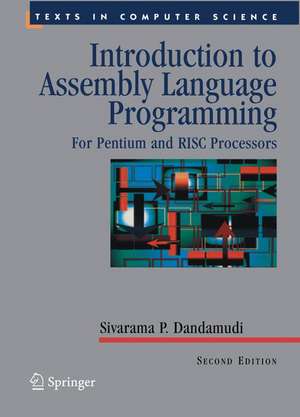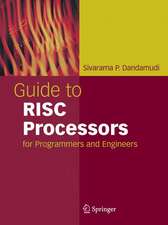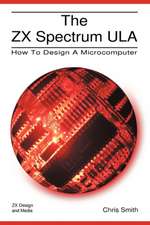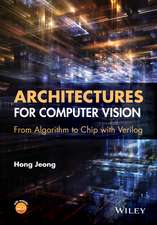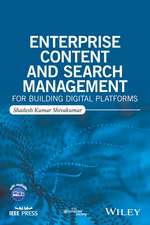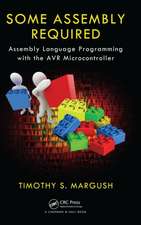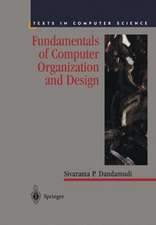Introduction to Assembly Language Programming: For Pentium and RISC Processors: Texts in Computer Science
Autor Sivarama P. Dandamudien Limba Engleză Hardback – 5 noi 2004
Topics and Features: Introduces assembly language so that readers can benefit from learning its utility with both CISC and RISC processors [ NEW ].- Employs the freely available NASM assembler, which works with both Microsoft Windows and Linux operating systems [ NEW ].- Contains a revised chapter on "Basic Computer Organization" [ NEW].- Uses numerous examples, hands-on exercises, programming code analyses and challenges, and chapter summaries.- Incorporates full new chapters on recursion, protected-mode interrupt processing, and floating-point instructions [ NEW ].
Assembly language programming is part of several undergraduate curricula in computer science, computer engineering, and electrical engineering. In addition, this newly revised text/reference can be used as an ideal companion resource in a computer organization course or as a resource for professional courses.
| Toate formatele și edițiile | Preț | Express |
|---|---|---|
| Paperback (1) | 669.02 lei 6-8 săpt. | |
| Springer – 19 noi 2010 | 669.02 lei 6-8 săpt. | |
| Hardback (1) | 624.50 lei 6-8 săpt. | |
| Springer – 5 noi 2004 | 624.50 lei 6-8 săpt. |
Din seria Texts in Computer Science
- 20%
 Preț: 406.21 lei
Preț: 406.21 lei - 20%
 Preț: 370.59 lei
Preț: 370.59 lei - 20%
 Preț: 411.53 lei
Preț: 411.53 lei - 20%
 Preț: 417.80 lei
Preț: 417.80 lei - 20%
 Preț: 306.37 lei
Preț: 306.37 lei - 20%
 Preț: 411.75 lei
Preț: 411.75 lei - 20%
 Preț: 1244.39 lei
Preț: 1244.39 lei - 20%
 Preț: 503.88 lei
Preț: 503.88 lei - 20%
 Preț: 444.93 lei
Preț: 444.93 lei - 20%
 Preț: 474.58 lei
Preț: 474.58 lei - 20%
 Preț: 305.31 lei
Preț: 305.31 lei - 20%
 Preț: 675.36 lei
Preț: 675.36 lei - 20%
 Preț: 423.53 lei
Preț: 423.53 lei - 20%
 Preț: 441.71 lei
Preț: 441.71 lei -
 Preț: 506.24 lei
Preț: 506.24 lei - 20%
 Preț: 366.94 lei
Preț: 366.94 lei - 20%
 Preț: 370.23 lei
Preț: 370.23 lei - 20%
 Preț: 515.36 lei
Preț: 515.36 lei - 15%
 Preț: 637.58 lei
Preț: 637.58 lei - 20%
 Preț: 353.34 lei
Preț: 353.34 lei - 20%
 Preț: 356.82 lei
Preț: 356.82 lei - 20%
 Preț: 181.92 lei
Preț: 181.92 lei - 20%
 Preț: 330.42 lei
Preț: 330.42 lei - 20%
 Preț: 743.62 lei
Preț: 743.62 lei - 20%
 Preț: 663.45 lei
Preț: 663.45 lei -
 Preț: 457.75 lei
Preț: 457.75 lei - 20%
 Preț: 536.66 lei
Preț: 536.66 lei -
 Preț: 385.84 lei
Preț: 385.84 lei - 20%
 Preț: 358.24 lei
Preț: 358.24 lei - 20%
 Preț: 394.57 lei
Preț: 394.57 lei - 20%
 Preț: 344.76 lei
Preț: 344.76 lei - 20%
 Preț: 621.18 lei
Preț: 621.18 lei - 20%
 Preț: 350.86 lei
Preț: 350.86 lei - 20%
 Preț: 348.89 lei
Preț: 348.89 lei - 20%
 Preț: 339.95 lei
Preț: 339.95 lei - 20%
 Preț: 588.21 lei
Preț: 588.21 lei - 20%
 Preț: 199.57 lei
Preț: 199.57 lei - 20%
 Preț: 341.30 lei
Preț: 341.30 lei - 23%
 Preț: 726.94 lei
Preț: 726.94 lei - 20%
 Preț: 325.30 lei
Preț: 325.30 lei - 20%
 Preț: 595.80 lei
Preț: 595.80 lei - 20%
 Preț: 593.48 lei
Preț: 593.48 lei -
 Preț: 454.31 lei
Preț: 454.31 lei
Preț: 624.50 lei
Preț vechi: 780.62 lei
-20% Nou
Puncte Express: 937
Preț estimativ în valută:
119.54€ • 129.89$ • 100.48£
119.54€ • 129.89$ • 100.48£
Carte tipărită la comandă
Livrare economică 21 aprilie-05 mai
Preluare comenzi: 021 569.72.76
Specificații
ISBN-13: 9780387206363
ISBN-10: 0387206361
Pagini: 692
Ilustrații: XXIV, 692 p.
Dimensiuni: 178 x 235 x 43 mm
Greutate: 1.41 kg
Ediția:2nd ed. 2005
Editura: Springer
Colecția Springer
Seria Texts in Computer Science
Locul publicării:New York, NY, United States
ISBN-10: 0387206361
Pagini: 692
Ilustrații: XXIV, 692 p.
Dimensiuni: 178 x 235 x 43 mm
Greutate: 1.41 kg
Ediția:2nd ed. 2005
Editura: Springer
Colecția Springer
Seria Texts in Computer Science
Locul publicării:New York, NY, United States
Public țintă
Lower undergraduateCuprins
Overview.- Basic Computer Organization.- Pentium Assembly Language.- The Pentium Processor.- Overview of Assembly Language.- Procedures and the Stack.- Addressing Modes.- Arithmetic Flags and Instructions.- Selection and Iteration.- Logical and Bit Operations.- String Processing.- ASCII and BCD Arithmetic.- MIPS Assembly Language.- MIPS Processor.- MIPS Assembly Language.- Interrupt Processing.- Protected-Mode Interrupt Processing.- Real-Mode Interrupts.- Advanced Topics.- Recursion.- High-Level Language Interface.- Floating-Point Operations.
Textul de pe ultima copertă
Assembly language continues to hold a core position in the programming world because of its similar structure to machine language and its very close links to underlying computer-processor architecture and design. These features allow for high processing speed, low memory demands, and the capacity to act directly on the system’s hardware.
This completely revised second edition of the highly successful Introduction to Assembly Language Programming introduces readers to assembly language programming and its role in computer programming and design. It focuses on providing a firm grasp of the main features of assembly programming, and how it can be used to improve a computer's performance. The revised edition covers a broad scope of subjects and adds valuable material on protected-mode Pentium programming, MIPS assembly language programming, and use of the NASM and SPIM assemblers for a Linux orientation. All of the language's main features are covered in depth. The bookrequires only some basic experience with a structured, high-level language.
Topics and Features:
*Introduces assembly language so that readers can benefit from learning its utility with both CISC and RISC processors [ NEW ]
*Employs the freely available NASM assembler, which works with both Microsoft Windows and Linux operating systems [ NEW ]
*Contains a revised chapter on "Basic Computer Organization" [ NEW]
*Uses numerous examples, hands-on exercises, programming code analyses and challenges, and chapter summaries
*Incorporates full new chapters on recursion, protected-mode interrupt processing, and floating-point instructions [ NEW ]
*Supplies up-to-date details, examples, and software via the author’s website
*Provides excellent appendixes and a comprehensive index
Assembly language programming is part of several undergraduate curricula in computer science, computer engineering, and electrical engineering. In addition, this newly revised text/reference can be used as an ideal companion resource in a computer organization course or as a resource for professional courses or self-study.
This completely revised second edition of the highly successful Introduction to Assembly Language Programming introduces readers to assembly language programming and its role in computer programming and design. It focuses on providing a firm grasp of the main features of assembly programming, and how it can be used to improve a computer's performance. The revised edition covers a broad scope of subjects and adds valuable material on protected-mode Pentium programming, MIPS assembly language programming, and use of the NASM and SPIM assemblers for a Linux orientation. All of the language's main features are covered in depth. The bookrequires only some basic experience with a structured, high-level language.
Topics and Features:
*Introduces assembly language so that readers can benefit from learning its utility with both CISC and RISC processors [ NEW ]
*Employs the freely available NASM assembler, which works with both Microsoft Windows and Linux operating systems [ NEW ]
*Contains a revised chapter on "Basic Computer Organization" [ NEW]
*Uses numerous examples, hands-on exercises, programming code analyses and challenges, and chapter summaries
*Incorporates full new chapters on recursion, protected-mode interrupt processing, and floating-point instructions [ NEW ]
*Supplies up-to-date details, examples, and software via the author’s website
*Provides excellent appendixes and a comprehensive index
Assembly language programming is part of several undergraduate curricula in computer science, computer engineering, and electrical engineering. In addition, this newly revised text/reference can be used as an ideal companion resource in a computer organization course or as a resource for professional courses or self-study.
Caracteristici
Introduces assembly language programming using either Pentium or RISC processors and either DOS or Linux and adds new material on protected-mode Pentium programming, MIPS assembly language programming, and use of the NASM and SPIM assemblers for a Linux orientation Includes supplementary material: sn.pub/extras
